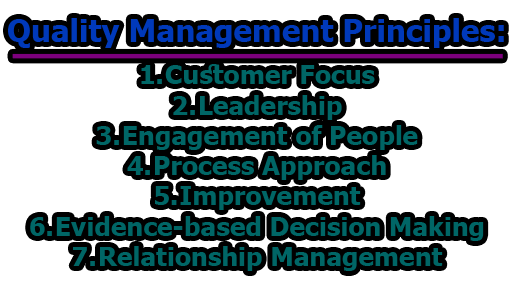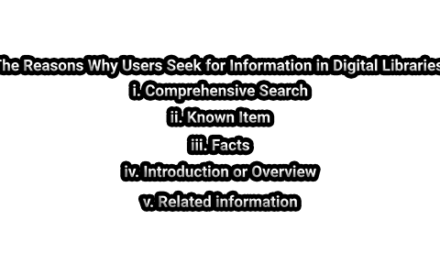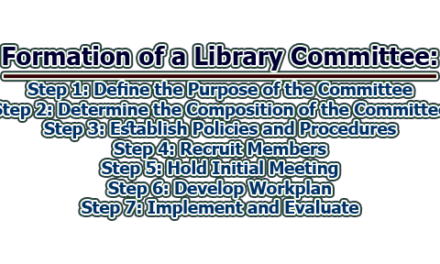Quality management is the process of ensuring that products or services meet or exceed customer expectations. It involves developing and implementing systems and procedures to ensure that products or services consistently meet or exceed quality standards. Quality management is essential in ensuring customer satisfaction, improving organizational efficiency, and reducing costs associated with rework, errors, and defects. Quality management involves various activities such as setting quality objectives, defining quality standards, monitoring and controlling processes, and continuously improving products and services. It may also involve measuring and analyzing data to identify areas for improvement, implementing quality control measures, and providing training and support to employees to ensure that they understand and follow quality procedures. In the rest of this article, we are going to know about quality management principles, approaches, benefits, and quality management in libraries.
Definitions of Quality Management:
Some of the necessary definitions are given below:
“Quality management is the set of activities that organizations carry out to ensure that their products or services meet or exceed customer expectations. It is a systematic approach to achieving quality that involves setting quality objectives, defining quality standards, monitoring and controlling processes, and continuously improving products and services.” – American Society for Quality
“Quality management is the coordination of activities that direct and control an organization with regard to quality. It involves setting quality objectives, determining policies and procedures, and assigning responsibility and authority for achieving quality goals.” – International Organization for Standardization
“Quality management is a management approach that seeks to optimize the quality of an organization’s products or services by continuously improving processes and systems. It involves measuring and analyzing data, identifying areas for improvement, and implementing corrective actions to ensure that products and services meet or exceed customer expectations.” – Harvard Business Review
“Quality management is a philosophy and a set of guiding principles that strive to continuously improve organizational performance by delivering products and services that meet or exceed customer expectations. It involves identifying and managing quality risks, continuously improving processes, and fostering a culture of quality throughout the organization.” – Project Management Institute
“Quality management is the process of meeting the needs and expectations of customers by planning, organizing, controlling, and continuously improving an organization’s products or services. It involves understanding customer requirements, identifying quality standards, and implementing quality control measures to ensure that products and services meet or exceed expectations.” – Investopedia
Quality Management Principles:
Here are the seven quality management principles with their rationales:
- Customer Focus: The principle of customer focus means that organizations should understand and meet the needs of their customers. By focusing on the customer, organizations can improve customer satisfaction, loyalty, and retention.
Rationale: By focusing on the customer, organizations can improve customer satisfaction, build customer loyalty, and gain a competitive advantage in the marketplace. For example, a company that provides excellent customer service and consistently delivers high-quality products is likely to have satisfied and loyal customers who will continue to do business with them.
- Leadership: The principle of leadership means that leaders should establish unity of purpose and direction for the organization. Leaders should create and maintain an environment in which people can become fully involved in achieving the organization’s quality objectives.
Rationale: Effective leadership is essential for creating a culture of quality and achieving quality objectives. For example, a CEO who sets clear quality objectives and empowers employees to achieve those objectives is likely to have a more engaged and motivated workforce, which can lead to improved quality and performance.
- Engagement of People: The principle of engagement of people means that people at all levels of the organization should be involved in the quality management process. By involving people in the process, organizations can increase employee motivation, engagement, and commitment to achieving quality objectives.
Rationale: Engaging employees in the quality management process can improve motivation, commitment, and innovation. For example, a company that encourages employee feedback and ideas for improvement is likely to have a more engaged workforce, which can lead to improved quality and performance.
- Process Approach: The principle of process approach means that organizations should manage their activities and related resources as a process. By adopting a process approach, organizations can achieve consistent and predictable results, reduce errors and rework, and improve efficiency and effectiveness.
Rationale: Managing processes to achieve quality objectives can improve efficiency, reduce errors and waste, and achieve consistent and predictable results. For example, a company that uses a standardized process for product design and development is likely to produce products that meet customer needs and expectations more consistently.
- Improvement: The principle of improvement means that organizations should strive for continual improvement of their overall performance. By continually improving, organizations can improve quality, reduce costs, and increase customer satisfaction.
Rationale: Continual improvement is essential for achieving quality objectives and meeting the evolving needs of customers. For example, a company that regularly reviews and improves its processes and products is likely to have a more competitive and successful business.
- Evidence-based Decision Making: The principle of evidence-based decision-making means that effective decisions should be based on the analysis of data and information. By using data and evidence to make decisions, organizations can identify trends, establish facts, and make informed decisions that lead to improved quality.
Rationale: Using data and evidence to make decisions can lead to more informed and effective decision-making. For example, a company that uses customer feedback and sales data to make product development decisions is likely to produce products that better meet customer needs and expectations.
- Relationship Management: The principle of relationship management means that organizations should manage their relationships with suppliers and other stakeholders to enhance the ability of both parties to create value. By managing relationships with suppliers and other stakeholders, organizations can improve collaboration, reduce risk, and create value.
Rationale: Effective relationship management can lead to improved collaboration, reduced risk, and increased value for both parties. For example, a company that has strong relationships with its suppliers is likely to have a more reliable and efficient supply chain, which can lead to improved quality and performance.
Quality Management Approaches:
Quality Management Approaches refer to the different ways in which organizations ensure that their products and services meet or exceed customer expectations. There are several approaches to quality management, including Quality by Inspection, Quality by Process Control, and Quality by Design. Here’s a brief explanation of each approach and its basic stages:
- Quality by Inspection: This approach involves inspecting finished products to identify defects and errors before they reach customers. The basic stages of Quality by Inspection include:
- Product Inspection: Inspect the product to identify defects and errors.
- Reject/ Accept Decision: Deciding whether the product meets the required standards or needs to be rejected.
- Corrective Action: Taking corrective action to address the defects and errors.
While Quality by Inspection can help identify and correct defects, it can be costly and time-consuming, as it involves inspecting each product individually.
- Quality by Process Control: This approach involves controlling the production process to prevent defects and errors from occurring. The basic stages of Quality by Process Control include:
- Process Monitoring: Monitoring the production process to identify any deviations from the standard process.
- Process Analysis: Analyzing the data collected during process monitoring to identify any areas of improvement.
- Corrective Action: Taking corrective action to address any deviations and improve the process.
Quality by Process Control is more efficient than Quality by Inspection, as it prevents defects from occurring in the first place. However, it requires a significant investment in process monitoring and analysis.
- Quality by Design: This approach involves designing products and processes to meet customer needs and expectations. The basic stages of Quality by Design include:
- Customer Needs Analysis: Analyzing customer needs and expectations to determine the product requirements.
- Product Design: Designing the product to meet the identified requirements.
- Process Design: Designing the production process to ensure that the product meets the required standards.
Quality by Design is the most efficient and effective approach to quality management, as it ensures that products are designed and produced to meet customer needs and expectations from the outset. However, it requires a significant investment in research and development, and may not be practical for all organizations.
Quality Management Benefits:
Quality management offers many benefits to organizations, including:
- Improved customer satisfaction: By focusing on meeting customer needs and expectations, organizations can improve customer satisfaction and loyalty.
- Increased efficiency and productivity: Quality management techniques help organizations to streamline their processes, eliminate waste and reduce errors, which can lead to greater efficiency and productivity.
- Reduced costs: By improving quality and reducing waste, organizations can reduce their costs and improve their bottom line.
- Competitive advantage: Organizations that are known for their high-quality products and services can gain a competitive advantage over their competitors.
- Better decision-making: By using data and evidence to make decisions, organizations can make more informed and effective decisions.
- Improved employee morale and engagement: When employees are involved in quality improvement initiatives and see the impact of their work, they are likely to be more engaged and motivated.
- Legal compliance: Compliance with quality standards and regulations can help organizations avoid legal issues and penalties.
Quality Management in Libraries:
Quality management is an approach to ensuring that products and services meet or exceed customer expectations. In the context of libraries, quality management refers to the process of ensuring that library services and resources meet the needs and expectations of users.
Quality management in libraries involves several key components, including:
Customer Focus: The library must be focused on meeting the needs and expectations of its users. This involves understanding user needs, gathering feedback, and continuously improving library services and resources based on user feedback.
Leadership: The library must have strong leadership that is committed to quality management and that provides clear direction and support to staff. This involves setting quality objectives, communicating expectations, and providing resources and support to staff to help them achieve those objectives.
Engagement of People: The library must engage and empower its staff to ensure that they are able to contribute to quality management. This involves providing staff with training and development opportunities, soliciting feedback and ideas from staff, and recognizing and rewarding staff contributions to quality management.
Process Approach: The library must have processes in place to ensure that library services and resources are delivered consistently and efficiently. This involves documenting processes, monitoring performance, and continuously improving processes to ensure that they are effective and efficient.
Improvement: The library must continuously improve its services and resources based on user feedback and changing needs. This involves setting improvement objectives, monitoring performance, and making changes to improve library services and resources.
Evidence-Based Decision Making: The library must use data and evidence to make decisions about library services and resources. This involves gathering data on library performance, analyzing that data, and using it to inform decisions about library services and resources.
Relationship Management: The library must build and maintain relationships with key stakeholders, including users, staff, and community partners. This involves communicating effectively with stakeholders, understanding their needs and expectations, and continuously improving relationships to ensure that the library is meeting stakeholder needs.
Examples of quality management initiatives in libraries include:
User Surveys: Libraries may conduct surveys of users to gather feedback on library services and resources. This feedback can be used to identify areas for improvement and to make changes to library services and resources based on user needs.
Staff Training and Development: Libraries may provide training and development opportunities to staff to help them improve their skills and contribute to quality management. This can include training on customer service, process improvement, and other areas relevant to quality management.
Process Improvement: Libraries may use process improvement methodologies, such as Lean or Six Sigma, to improve library services and resources. This involves documenting processes, analyzing performance data, and making changes to improve process efficiency and effectiveness.
Data Analytics: Libraries may use data analytics tools to gather and analyze data on library services and resources. This data can be used to identify trends, measure performance, and make data-driven decisions about library services and resources.
In summary, quality management is an important component of library management. By focusing on user needs, engaging staff, using evidence-based decision-making, and continuously improving library services and resources, libraries can ensure that they are providing high-quality services and resources that meet the needs and expectations of users.
References:
- Juran, J. M., & Godfrey, A. B. (1998). Juran’s quality handbook (5th ed.). McGraw-Hill.
- Crosby, P. B. (1984). Quality without tears: The art of hassle-free management. McGraw-Hill.
- Deming, W. E. (1986). Out of the crisis. MIT Press.
- (2015). Quality management principles. International Organization for Standardization.
- American Library Association. (2008). Library bill of rights. Retrieved from https://www.ala.org/advocacy/intfreedom/librarybill
- International Federation of Library Associations and Institutions. (2015). IFLA/UNESCO Public Library Manifesto 1994. Retrieved from https://www.ifla.org/publications/iflaunesco-public-library-manifesto-1994
- Oakland, J. S. (2003). Total quality management: Text with cases (3rd ed.). Butterworth-Heinemann.
- Goetsch, D. L., & Davis, S. B. (2014). Quality management for organizational excellence (7th ed.). Pearson.
- Feigenbaum, A. V. (1991). Total quality control (3rd ed.). McGraw-Hill.
- Harrington, H. J. (1991). Business process improvement: The breakthrough strategy for total quality, productivity, and competitiveness. McGraw-Hill.
- Besterfield-Sacre, M. E., Besterfield, G. H., & Sacre, R. K. (2013). Total quality management (3rd ed.). Pearson.
- International Organization for Standardization. (2015). ISO 9001:2015 Quality management systems – Requirements. Retrieved from https://www.iso.org/standard/62085.html
- Ishikawa, K. (1985). What is total quality control? The Japanese way. Prentice-Hall.
- Dale, B. G. (2003). Managing quality (4th ed.). Blackwell.
- Oakland, J. S. (2007). Oakland on quality management. Butterworth-Heinemann.
- Juran, J. M. (1992). Juran on quality by design: The new steps for planning quality into goods and services. Free Press.
- Crosby, P. B. (1979). Quality is free: The art of making quality certain. New American Library.
- Harry, M. J., & Schroeder, R. (2000). Six sigma: The breakthrough management strategy revolutionizing the world’s top corporations. Doubleday.
- Zeithaml, V. A., Parasuraman, A., & Berry, L. L. (1990). Delivering quality service: Balancing customer perceptions and expectations. The Free Press.
- Camp, R. C. (1989). Benchmarking: The search for industry best practices that lead to superior performance. ASQC Quality Press.
- Garvin, D. A. (1988). Managing quality: The strategic and competitive edge. Free Press.
- Oakland, J. S. (2000). The TQM toolbox. Butterworth-Heinemann.
- Harrington, H. J. (1995). Business process improvement workbook: Documentation, analysis, design, and management of business process improvement. McGraw-Hill.
- Goetsch, D. L., & Stanley Davis, S. B. (2014). Quality management for organizational excellence: Introduction to total quality (7th ed.). Pearson.

Library Lecturer at Nurul Amin Degree College










